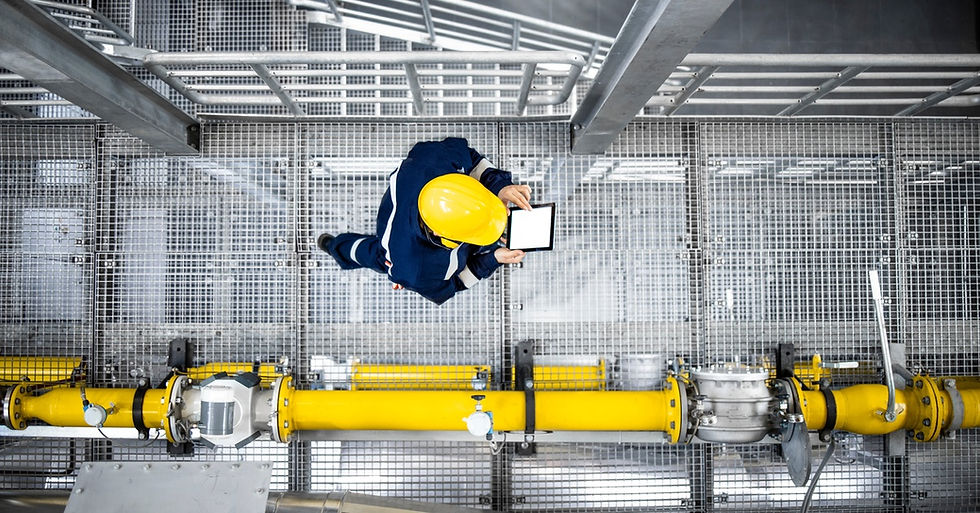Which Maintenance Strategy Suits Your Facility?
- Heidi Dorn
- Sep 11
- 4 min read

Maintaining a facility is a complex task that requires careful planning and execution. Unplanned equipment downtime can lead to financial losses, production delays, and safety risks. To avoid these problems, you need a solid maintenance strategy. However, with several options available, choosing the right one can be challenging.
This guide explores three main maintenance strategies: reactive, preventive, and predictive. Each has its own principles, benefits, and drawbacks. Understanding these strategies is key to optimizing your facility’s performance and longevity. By examining how they work, you can choose the one that best fits your goals, resources, and risk tolerance. Let’s break down what sets these approaches apart and how to find the best maintenance strategy to suit your facility.
Understanding Reactive Maintenance
Reactive maintenance, often called run-to-failure maintenance, is the simplest and most straightforward approach. In this model, technicians perform maintenance work only after a piece of equipment has broken down or failed.
There is no proactive scheduling or planning involved; maintenance teams simply react to problems as they arise. This strategy operates on the principle of fixing things only when they break, which can seem cost-effective in the short term since it eliminates the need for planning and regular servicing.
The Appeal of Simplicity
For some smaller facilities or non-critical equipment, reactive maintenance can be a viable option. If the failure of a particular asset does not significantly disrupt operations or pose a safety risk, waiting for it to break down before repairing it might be the most economical choice.
It requires minimal upfront investment in planning, personnel, or advanced technology. The focus is entirely on restoration, getting the failed equipment back online as quickly as possible.
The Hidden Costs of Failure
The apparent simplicity of reactive maintenance often conceals significant long-term costs and risks. Unplanned downtime is one of the biggest drawbacks. When critical machinery fails unexpectedly, it can halt production entirely, leading to missed deadlines and substantial revenue loss. The urgent nature of these repairs often means paying premium prices for parts and labor.
Additionally, catastrophic failures can cause collateral damage to other equipment and create serious safety hazards for employees. Over time, a purely reactive approach can lead to a chaotic work environment where maintenance teams are constantly fighting problems instead of strategically managing assets.

Exploring Preventive Maintenance
Preventive maintenance is a more proactive approach to facility management. This strategy involves performing regularly scheduled maintenance tasks on equipment to reduce the likelihood of failure. The goal is to address potential issues before they escalate into major problems that cause unexpected downtime.
Time-based or usage-based triggers, such as operating hours, production cycles, or calendar dates, determine the planning of maintenance activities. For instance, technicians might inspect and service a piece of machinery every three months, regardless of its current condition.
The Power of Planning
The primary advantage of preventive maintenance is its ability to increase equipment reliability and lifespan. By regularly servicing assets, you can catch and correct minor issues, preventing them from developing into costly failures.
Scheduled downtime is far more manageable and less disruptive than unexpected breakdowns. It allows for better planning of resources, labor, and inventory. This structured approach helps create a more organized and predictable maintenance environment, improving overall operational efficiency.
The Right Balance
While effective, preventive maintenance is not without its challenges. One potential downside is the risk of over-maintenance. Performing service on equipment that doesn’t need it can be wasteful, consuming valuable time, labor, and parts. It can also introduce new risks, as sometimes the process of disassembly and reassembly can create new problems.
The key to a successful preventive maintenance program is finding the optimal frequency for servicing each piece of equipment. This requires a deep understanding of the assets, their failure modes, and the manufacturer’s recommendations.
Looking at Predictive Maintenance
Predictive maintenance is the most advanced and data-driven of the three strategies. It uses condition-monitoring tools and advanced analytics to predict when a piece of equipment is likely to fail.
Instead of relying on a fixed schedule, technicians perform maintenance only when needed—just before an anticipated failure. This approach leverages technologies like vibration analysis, thermal imaging, oil analysis, and other sensor-based data to continuously monitor the health of an asset in real time.
Data-Driven Decisions
The core of predictive maintenance is its ability to provide early warnings of potential problems. By analyzing data trends, algorithms can detect subtle changes in equipment performance that indicate an impending failure.
This allows maintenance teams to intervene at the most opportune moment, minimizing downtime and maximizing the useful life of components. It is a highly efficient strategy because it eliminates unnecessary maintenance associated with a purely preventive approach and the unexpected failures of a reactive one.
The Investment in Technology
The main barrier to implementing a predictive maintenance program is the significant upfront investment. It requires the purchase and installation of monitoring sensors, data acquisition systems, and specialized software. It also requires a team with the skills to interpret the data and make informed decisions.
For many organizations, the cost and complexity can be daunting. However, for facilities with critical, high-cost assets, predictive maintenance can deliver significant returns, often outweighing initial costs by reducing downtime and optimizing resources.

Choosing the Right Strategy
The ideal maintenance strategy for your facility is rarely a one-size-fits-all solution. Most facilities benefit from a hybrid approach that combines elements of all three strategies. The key is to tailor the strategy to the specific needs of each piece of equipment.
For non-critical assets where failure has a minimal impact on operations, a reactive approach might be sufficient. For machinery with known failure patterns and moderate criticality, a preventive maintenance program is often the most practical choice. For high-value, critical equipment where unplanned downtime would be catastrophic, the investment in a predictive maintenance program is often justifiable. A thorough analysis of your facility’s assets, considering their criticality, failure history, and replacement cost, will help you determine the most effective mix of strategies.
MIC Group Preventive Maintenance Program
Devising and implementing a comprehensive preventive maintenance program can be a complex undertaking. At Mechanical Insulation Consulting Group, we specialize in helping industrial facilities develop and execute insulation maintenance strategies that protect assets and improve performance.
Our team of experienced industrial mechanical maintenance contractors can work with you to create a customized program that fits your unique operational needs and budget. Let us help you move from fighting problems to strategically managing your facility for long-term success. Contact us today to learn more.




Comments